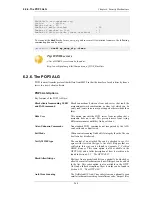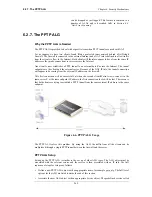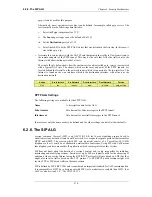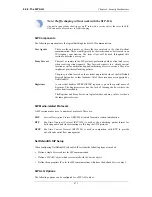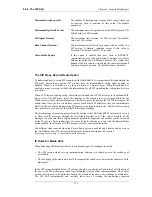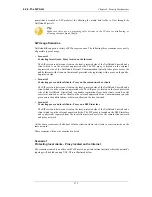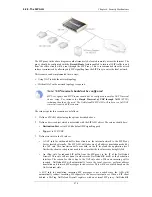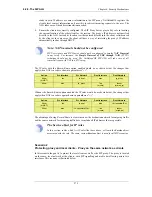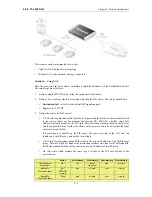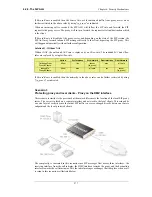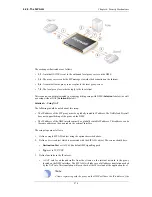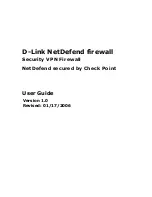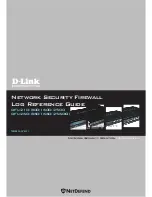
•
The H.323 ALG supports version 5 of the H.323 specification. This specification is built upon
H.225.0 v5 and H.245 v10.
•
In addition to support voice and video calls, the H.323 ALG supports application sharing over
the T.120 protocol. T.120 uses TCP to transport data while voice and video is transported over
UDP.
•
To support gatekeepers, the ALG monitors RAS traffic between H.323 endpoints and the
gatekeeper, in order to correctly configure the NetDefend Firewall to let calls through.
•
NAT and SAT rules are supported, allowing clients and gatekeepers to use private IP addresses
on a network behind the NetDefend Firewall.
H.323 ALG Configuration
The configuration of the standard H.323 ALG can be changed to suit different usage scenarios. The
configurable options are:
•
Allow TCP Data Channels - This option allows TCP based data channels to be negotiated.
Data channels are used, for example, by the T.120 protocol.
•
Number of TCP Data Channels - The number of TCP data channels allowed can be specified.
•
Address Translation - For NATed traffic the Network can be specified, which is what is
allowed to be translated. The External IP for the Network is specified which is the IP address
to NAT with. If the External IP is set as Auto then the external IP is found automatically
through route lookup.
•
Translate Logical Channel Addresses - This would normally always be set. If not enabled then
no address translation will be done on logical channel addresses and the administrator needs to
be sure about IP addresses and routes used in a particular scenario.
•
Gatekeeper Registration Lifetime - The gatekeeper registration lifetime can be controlled in
order to force re-registration by clients within a certain time. A shorter time forces more frequent
registration by clients with the gatekeeper and less probability of a problem if the network
becomes unavailable and the client thinks it is still registered.
Presented below are some network scenarios where H.323 ALG use is applicable. For each scenario
a configuration example of both the ALG and the rules are presented. The three service definitions
used in these scenarios are:
•
Gatekeeper (UDP ALL > 1719)
•
H323 (H.323 ALG, TCP ALL > 1720)
•
H323-Gatekeeper (H.323 ALG, UDP > 1719)
Example 6.4. Protecting Phones Behind NetDefend Firewalls
In the first scenario a H.323 phone is connected to the NetDefend Firewall on a network (lannet) with public IP
addresses. To make it possible to place a call from this phone to another H.323 phone on the Internet, and to
allow H.323 phones on the Internet to call this phone, we need to configure rules. The following rules need to be
added to the rule set, make sure there are no rules disallowing or allowing the same kind of ports/traffic before
these rules.
6.2.9. The H.323 ALG
Chapter 6. Security Mechanisms
282
Summary of Contents for DFL-1600 - Security Appliance
Page 27: ...1 3 NetDefendOS State Engine Packet Flow Chapter 1 NetDefendOS Overview 27 ...
Page 79: ...2 7 3 Restore to Factory Defaults Chapter 2 Management and Maintenance 79 ...
Page 146: ...3 9 DNS Chapter 3 Fundamentals 146 ...
Page 227: ...4 7 5 Advanced Settings for Transparent Mode Chapter 4 Routing 227 ...
Page 241: ...5 4 IP Pools Chapter 5 DHCP Services 241 ...
Page 339: ...6 7 Blacklisting Hosts and Networks Chapter 6 Security Mechanisms 339 ...
Page 360: ...7 4 7 SAT and FwdFast Rules Chapter 7 Address Translation 360 ...
Page 382: ...8 3 Customizing HTML Pages Chapter 8 User Authentication 382 ...
Page 386: ... The TLS ALG 9 1 5 The TLS Alternative for VPN Chapter 9 VPN 386 ...
Page 439: ...Figure 9 3 PPTP Client Usage 9 5 4 PPTP L2TP Clients Chapter 9 VPN 439 ...
Page 450: ...9 7 6 Specific Symptoms Chapter 9 VPN 450 ...
Page 488: ...10 4 6 Setting Up SLB_SAT Rules Chapter 10 Traffic Management 488 ...
Page 503: ...11 6 HA Advanced Settings Chapter 11 High Availability 503 ...
Page 510: ...12 3 5 Limitations Chapter 12 ZoneDefense 510 ...
Page 533: ...13 9 Miscellaneous Settings Chapter 13 Advanced Settings 533 ...

